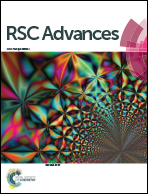Cu2O hollow structures—microstructural evolution and photocatalytic properties†
Abstract
In this paper, Cu2O Single-Shelled Hollow (SSH) sub-micron spheres, Multi-Shelled Hollow (MSH) sub-micron spheres and Multi-Shelled Porous (MSP) sub-micron spheres were successfully synthesized via a facile one-pot route in the presence of hexadecyltrimethylammonium bromide (CTAB) and ascorbic acid (VC). It is found that the morphology and structure of Cu2O hollow nanoparticles can be adjusted by changing alkalinity and aging time. The formation mechanism and structural evolution for these hollow structures is studied. Among three kinds of Cu2O hollow spheres, the Cu2O MSH sub-micron spheres demonstrated the best photo-catalytic (PC) property, which should attribute to the higher light absorption and smaller band gap.


 Please wait while we load your content...
Please wait while we load your content...